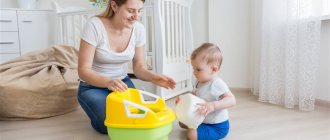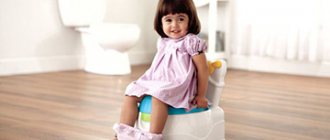A child grows and matures gradually, and one of the stages of growing up is the ability to hold urine, pouring it, if necessary, into a certain place. And the emergence of this skill brings no less joy and pride to the parents of the little man than the first smile or the first word. However, if the child begins to smile and speak on his own, then his mother and father should teach him to use the toilet. And it's very important to do it right. Komarovsky, a famous pediatrician and presenter, says the following about how to teach a child to go potty.
Getting to know the potty is not a feat!
Many modern mothers are passionate about the topic of early development. They keep special diaries of successes and discoveries and constantly brag about the kids’ new achievements to their friends. Very often, successful potty training is included in the category of such feats. In fact, there is nothing magical or extraordinary about the “correct” fulfillment of natural physiological needs. Do any adults (with the exception of those who suffer from some specific diseases) pee in their pants? Or perhaps he is proud of the fact that he makes it to the toilet? In fact, it is a personal decision for each family when and how to potty train a child. Komarovsky advises waiting until the optimal age and not concentrating too much on this issue. Parents should not forget that sooner or later the child will successfully learn to control his physiological needs.
Bedtime story
Often children do not control their bladder because they sleep restlessly.
In order for your baby to get a good night's sleep, he needs to be prepared for bed. For this:
- Before bed, tell your baby a story;
- keep him busy with quiet play;
- sing a lullaby;
- dim the lights, turn off the TV;
- Give him a relaxing massage before bed.
In a word, the hour and a half before going to bed should pass in a calm environment. During this time, the child will relax and calm down. Consequently, you will sleep peacefully and wet your diapers less.
Young children have nightmares more often than adults. This is why it is so important to teach them to properly prepare for bed.
Ways to teach your baby to get up at night to use the toilet or potty
- Learn to sleep without a diaper. The first thing that is important to do is not to put a diaper on your baby. Waking up wet, he will call his parents. After several such nights, the child may understand the cause-and-effect relationship and wake up in advance, before peeing. As a precaution, it is recommended to use disposable absorbent diapers. This option may not be suitable for all children, as some do not wake up even after peeing. Here, each mother must evaluate for herself whether this method is suitable for her child.
- Waking up by the clock. The child can be encouraged to get up to use the toilet or potty at a certain time in the middle of the night and explain to him that it is time to pee. It is very important that the baby is not completely sleepy, but aware of what is happening. This way, he will gradually develop the habit of waking up at night to go to the toilet.
- Incentives. From the age of 2 years, external motivation and rewards work well with children. You can create a poster of achievements, where you record all the child’s successes, both with sleep and with waking up to pee. For example, give him stickers for “dry nights”, and when he has a certain number of stickers, give him a small gift.
- Play during the day, imitation. While the baby is awake, you can play out the situation with the potty, saying them. The experience of learning to awaken should be internalized into the baby’s psyche - become his personal experience. This may take some time, where the help and explanations of the parents will create a basis for the baby’s understanding of the situation, and playing it will strengthen this experience.
The most important thing in any training is the attitude of the parents. It happens that despite all the steps being performed correctly, something still doesn’t work out, and the baby continues to pee without waking up. In this case, you can give yourself and him a little more time and shift the focus from this situation to other significant topics in your life with your baby. And then, quite likely, training in night awakenings will also begin to produce positive results.
Any skill comes when the child is ready for it, not only from a physiological point of view, but also psychologically, which is exactly what parents can help him with.
What can parents do to make potty training easier?
- Remember about age restrictions. If the baby is less than 2 years old, but at the same time he is already quite independent and already knows a lot and can do something without the help of his parents, then he can start potty training. But it is also important to remember that a high degree of self-organization should not yet be expected from a child much younger than 2 years old due to physical development and insufficient maturity of the nervous system.
- If the baby is not healthy, he needs the help of his parents . It is important for parents to understand that potty training is not only an educational psychological process, but also a process that largely depends on physiology. In the case of some diseases, you should be patient and not insist on a quick result.
- Help your child develop his independence. After the baby reaches the age of 1 year, parents’ encouragement of the child’s independent actions is one of the main forms of stimulation of his development and strengthening of attachment. The development of a baby largely depends on the environment in which he grows up: how safe the environment is, how many opportunities there are for trial and error, how willing parents are to support the baby in his endeavors (first steps, falls, first words and desires).
The child should have his own personal area of responsibility, that small area where he does something himself (assembles the pyramid himself, walks himself, eats with a spoon himself). Despite the fact that his mother is nearby, encouraging and supporting him, but without interfering unnecessarily.
- The last, but very important point is the baby’s ability to fall asleep on his own. The acquired skill of falling asleep independently will help the baby in learning to wake up on the potty. Knowing how to fall asleep on his own, it will be easier for him to wake up on his own, feeling his needs.
Optimal age
A potty should not appear in a child's life until 18 months.
It is by this age that the skills of conscious urination are formed. You can achieve significant success (and quite quickly!) in about 22-30 months. It is after one and a half years of age that a child can control his own body and understand what his parents want from him. In any case, this is what Dr. Komarovsky says. How to potty train a child without unnecessary hassle?
Before you start teaching this skill, you should make sure that the baby is really psychologically and physically ready. Don't start too early. Many mothers are proud of the fact that they manage to “catch” their baby up to a year old and “take him to the toilet correctly.” This strategy actually has nothing to do with potty training. Dr. Komarovsky recommends not giving up diapers until the age of one and a half years. In our age, enough accessories and ingenious devices have been invented, thanks to which women can fully enjoy the joys of motherhood with a minimum amount of hassle.
Why does relapse occur?
A healthy adult has no difficulty in controlling urination, thanks to the brain, which receives a signal from a full bladder. In an infant, the cerebral cortex is just beginning to form, and that is why conscious urination is out of the question.
But an attentive mother can notice the moment before direct urination - the baby makes a slight effort, his eyes turn slightly red, he may make some sound. Determining the onset of defecation is even easier: when breastfeeding, the baby often defecates during feeding, he begins to fuss, restlessly suck the breast, arch, and when he is older, having already formed a stool, the child clearly pushes. So, when they talk about potty training a child until at least one year old, we are talking more about watching for such periods.
However, if each time the action itself is voiced with a characteristic word, then over time the child will develop a reflex: there is a signal, he needs to pee. This reflex, like Pavlov’s dog, will be incorrect, since in nature the opposite should happen: there is a desire to pee, there is defecation.
The child will grow, the brain will develop and the signal may stop working, the baby will refuse to urinate on command, resistance will increase, and wet pants will appear. You will have to learn to relieve yourself on the potty again, but not by a sound stimulus, but by a natural physiological need.
How do you know when your baby is ready to use the potty?
At what age should you potty train your child? Komarovsky advises all parents to remember the main signs of a child’s readiness to master this skill. You should think about purchasing a potty if your child relieves himself quite rarely. Namely, if the baby is able to stay dry for 2 hours or more. Establishing a bowel movement routine is also important. The child will learn to use his first toilet if he understands the words associated with the poisoning of natural needs. It is also worth paying attention to how the baby reacts to dirty or wet pants. If the child realizes discomfort and shows dissatisfaction, then it’s time to get acquainted with the potty.
How to teach a child to ask
There are a huge number of methods for teaching a child to ask to go to the toilet at night or to do without it altogether.
The second option is more preferable.
Small children sleep very soundly; their bodies are not yet able to wake up after the urge to relieve themselves.
Moreover, this applies not only to nighttime sleep, but also to daytime sleep.
Disposable diapers are, of course, a way out of the situation, but many parents try to get rid of them as quickly as possible. In this case, the child wets the diaper. And if you wash the last part, you don’t want to leave your baby sleeping in a wet bed. There is only one thing left - to teach the child to ask to go to the potty at night.
Rules for choosing a potty and the baby’s first acquaintance with it
Modern manufacturers of children's products offer an impressive range of children's potties. Note! For girls, you should choose round-shaped products, and for boys, oval ones. The first pot should be made of plastic. Why are iron “night vases” bad? They can be cold and cause discomfort for the baby. It is also important that the pot is stable enough and has a back. “You shouldn’t turn going to the toilet into a game,” says Dr. Komarovsky. Not all parents know how to potty train a child quickly. Many people think that it is necessary to entertain the baby. In fact, from the very first time the child must understand why a new household item is needed. It is for this reason that you should not buy pots that resemble development centers. Built-in play panels and rattles will only distract the baby.
Which potty should a child choose?
Surprisingly, the producers did their best here too. A wide variety of types of this item have been invented for children: all colors of the rainbow, musical, in the form of horses, cars.
Which one should you choose for your baby? Simplest! First of all, the child should know that the potty is not a toy, it is an item that must be used strictly for its intended purpose. The presence of gaming paraphernalia will distract the baby and interfere with concentration, and music can develop an unnecessary unconditioned reflex.
The pot must be suitable in size and comfortable; having a back will not hurt. You should sit on it correctly: your back and legs should be straight, otherwise there will be pressure on the pelvic diaphragm, which can also subsequently cause hemorrhoids and fissures.
How and when to start potty training your child? Komarovsky advises
- It is important to introduce your child to the potty and try to explain to him what it is and what it is for.
- You should put your child on the potty after waking up and at the first sign that he wants to go to the toilet.
- Be sure to praise your baby every time you manage to do all your chores carefully. You can even exaggerate your own joy, but it is important to clearly identify success and the reasons for praise.
- When and at what time should you potty train your child? Komarovsky advises starting in the warm season. Try to leave your baby out of diapers more often while awake. It is important that the child realizes how nice it is to be clean. Be sure to make sure that the baby will not freeze or catch a cold.
How to refuse a diaper on the street?
With the advent of the same stable skill of using the potty, you can slowly wean yourself off the street diaper. The most favorable time is summer, when, if necessary, you can go into the bushes or, in the event of a wet accident, you can easily change your suit. Don't forget to regularly ask your child if they want to go to the toilet. But take the process intimately. There is no need to shout loudly or force him to urinate in the middle of the yard - the child may be embarrassed. If successful, do not skimp on praise.
A good alternative to diapers for an easy transition can be panty diapers - they are almost like real ones, but still just as absorbent. Even if the child does things in them, still ask him to sit on the potty, so he will have a strong association and over time he will begin to ask. It is also advisable to relieve yourself at home before your walk.
Where to send a child at 4 years old, read in our article. What size and how many diapers does a newborn baby need?
What contraceptives can be used by nursing mothers, read in this article
We praise for successes, but do not notice failures!
One of the secrets to successful potty training lies in the complete absence of criticism. Even if the child doesn’t succeed in something right away, parents should not scold him. It is better not to notice such an embarrassment at all. And this is an important rule, because sharp criticism can permanently discourage a child from sitting on the potty or even just approaching him. Komarovsky speaks regularly about the rules for developing hygiene skills and how to potty train a child. The famous doctor advises finding a compromise between the child’s education and convenience for parents. Diapers can be used during sleep, walks and visits until the baby learns to fully control himself. At home, you should give your baby the opportunity to walk around in panties. It is important that the floor is warm and its coating is easy to clean.
It doesn’t work: reasons
If, in your opinion, the child is already old enough (over 3 years old), but potty training just isn’t working out, your pediatrician might be a good idea. The cause may be a disease. For example, cystitis can affect urinary incontinence. This is an infectious disease that occurs mainly in girls. Due to the peculiarities of their physiological structure (compared to boys), improper hygienic care can have such unpleasant consequences.
The frequency of urination depends on the age and weight of the child. With a small build, a child will also have a relatively small bladder, which will cause shorter intervals between urges.
Causes of enuresis:
- Psycho-emotional immaturity of the baby
- Hereditary factor
- Consequence of injury
- Urinary tract infection
- Delayed development of the nervous system
- Neurological diseases
An examination by a qualified specialist, a clinical urine test, and an ultrasound will help clarify the situation. So, if you have a healthy normal child, then you should not be upset about failures in potty training. All you have to do is show parental sensitivity, affection and patience, and you won’t even notice how over and over again your baby will voluntarily ask to go to the potty.
Video about when can you stop wearing diapers?
Potty games
The child should associate the potty directly with the discharge of natural needs. If for some reason the baby does not show interest in this product, you can try to correct the situation. How to potty train a child using games? Komarovsky's advice on this issue may seem strange to some parents, but it really works. It is very good if a parent of the same sex as the child tells him about how he himself goes to the toilet. If necessary, you can even show the whole process - take the child to an adult toilet on an excursion. Young children love to imitate their parents. Believe me, such training will be incredibly effective. If for some reason your baby is negative or wary of the potty, you can play with him a little. “Take your child’s favorite toys to the toilet and show that they are not afraid and know what to do.
Talk everything over with your child
Spend some time during the day in the weeks leading up to bedtime weaning to explain to your baby why he needs to get out of his warm crib and go to the toilet, and show him how it works in practice. Offer rewards for successful nighttime toilet trips, and if your child has older siblings, include them in the process. This way things will definitely go faster.
Your child may have questions such as will he be able to call you for help if something happens if he doesn't see something at night? Explain that it is just as important at night as during the day to follow the same personal hygiene rules: wiping, flushing, and washing your hands after using the toilet.
Make nighttime trips to the toilet as comfortable as possible for your child by using soft toilet paper.
Secrets of strengthening the right habits
Rituals are of great importance for children. A set of actions repeated day after day gives the child a feeling of stability and security. So why not include going to the toilet as part of your daily rituals? Place your baby on the potty after sleep, walks and meals. Try to explain to the baby that he can and should ask to go to the toilet himself at the first desire. Many parents choose not the most beautiful things as home clothes for their children. And this is a big mistake. Early childhood development experts advise always dressing your baby neatly. It wouldn’t hurt to draw the little one’s attention to his appearance and unobtrusively ask him to get dirty less. Of course, you will still have to wash off stubborn stains from time to time. But with modern household chemicals, this is not too difficult a task.
Calm, just calm!
Unpleasant accidents in the process of teaching a child to get up on the potty at night cannot be avoided. Sometimes they happen even when you already began to think that everything worked out. Don't worry - this is completely normal. The main thing is not to be nervous and control yourself, and everything will be in order. If your child sees that nothing bad will happen, even if he wakes up wet, he will feel more confident and the potty training process will go much faster. And you can congratulate yourself on another achievement in your life and the life of your baby.
Why do younger children learn faster than older children?
In families with two or more children, the question is very rarely asked: “How to properly potty train a child?” Komarovsky notes that parents with many children usually experience the least amount of difficulties with developing personal hygiene skills. The secret is simple - younger children, observing older ones, copy their behavior. For this reason, in large families there are usually no difficulties with potty training or hand washing. What should families do when they have their first child? If possible, organize communication for the baby with slightly older children. If you regularly provide your child with the opportunity to play at home with cousins or children of your friends who are a little older than him, he will easily learn their healthy habits.
Should I limit the amount of liquid?
Many parents, wanting to quickly cope with how to teach their child to pee on the potty at night, begin to limit fluid intake. Of course, this makes sense: the bladder fills more slowly, in the morning the mother will be able to calmly put the baby on the potty, and the bed will remain dry. However, it is better to regulate consumption than to strictly limit it.
During the day, let your child drink as much as he needs. After dinner, you can offer him a cup of weak tea, a glass of juice or milk. But 3-4 hours before bedtime, you should stop drinking any liquid.
In the evening, you should not give your child drinks with caffeine. Eating foods such as melon and watermelon before bed is strictly prohibited.
Parents should make sure that an hour before bedtime the baby sits on the potty several times at intervals of 20 minutes. This is the best protection against puddles in the crib. After the first emptying, the bladder tends to fill again. But after going to the potty three times, the baby will be able to remove several times more fluid.
Parents should remember that strictly limiting drinking does not solve the problem. Every parent needs to know how to teach a child to get up on the potty at night.
Popular mistakes parents make
What not to do and how to potty train a child? Komarovsky recommends approaching this issue responsibly. The most common mistake parents make is introducing their baby to the potty too early. It makes no sense to require conscious trips to the toilet from a baby under one year old. The optimal age for instilling this skill is considered to be 1.5-3 years. You should not introduce the potty during difficult moments in your child’s life. If the family has recently moved to a new location or faced some other change, wait a while. Sometimes the first “correct” trip to the toilet causes negative emotions in the baby. If a child is frightened by something, knocks or is unhappy for any other reason, it makes sense to stop using the potty for about a week. Remember: forcing your baby to do something against his will will not achieve positive results.
Choosing the right time
Many mothers start putting their babies on the potty as soon as they learn to sit steadily, but this has nothing to do with potty training.
Children begin to use the potty on their own when they understand the connection between the natural process of emptying and the potty. The child must be prepared for this physiologically and morally.
A child can be potty trained if:
- after sleep the baby wakes up dry
- he may temporarily hold back urination
- he has regular bowel movements
- he is uncomfortable in wet pants or he protests against a dirty diaper
- it stays dry for a long time
- he himself shows interest in toilet matters
- understands that dirty pants or a diaper are bad.
You can start getting acquainted with the potty from 6 to 8 months, but Dr. Komarovsky advises doing this when the baby is a year and a half old. Of course, this is not a one-day process and can last up to three years.
The best time is summer, this way the clothes will dry faster and you won’t be afraid that your child will catch a cold. The time it takes for your baby to learn to use the potty is purely individual, some can do it in a week, others in several months.
Useful tips
And don’t forget: you can’t scold a child for being careless.
How and when should you potty train your child? Komarovsky recommends choosing a moment when the baby is healthy and feeling well. It is quite important at first to constantly praise the child for his successes. Parents must remember that praise should not be material. It is enough to say something encouraging, stroke and kiss the baby. But it’s not worth giving candy and new toys for successful potty training. The formation of hygiene skills should not be associated with receiving gifts. Let it be better perceived by the baby as a natural stage of growing up. Very often, grandmothers and other representatives of the older generation advise to accustom one to the “correct” discharge of natural needs as early as possible. Try to politely refuse such advice. Do not forget that in the USSR, most children at the age of 1 year began to attend nurseries. In them, the ability to use this accessory was welcomed. Today, each family can independently decide at what age to instill this skill in their child. Don't plan in advance what time to potty train your child. Komarovsky advises monitoring the baby and focusing on his personal needs. In any case, sooner or later your child will learn to control his physiological needs.
How to refuse a night diaper?
The diaper was included in the 30 inventions of the 20th century, which radically changed the daily life of a person. Now you can’t argue with this. When used correctly, disposable baby diapers make life much easier for parents and provide comfort to babies' tender bottoms. However, no matter what advantages this wonderful invention has, you should not abuse it. Children's skin will only benefit from contact with air, and a bare-bottomed baby will also bring great pleasure to the mother.
At the age of approximately 5-6 months, children go to the bathroom very often - on average up to 26 times a day. And if during the day, in the absence of a diaper, the mother can control the dryness of her panties and react in a timely manner, then at night she will still prefer a diaper. Although, if you wish, you can leave the baby without such insurance.
With restful sleep, there is a high probability that the child will not urinate in his sleep. If the days are warm, or you have the opportunity and strength to check on your baby in the middle of the night, then you can try to do without a diaper. If the child often wakes up and the room is cool, then the experiment with changing wet clothes may not be entirely successful and will cost you unnecessary movements and the baby’s dissatisfaction.
After switching from a diaper to a potty, you should gradually give up the night diaper (if you have not already done so). If a child has already developed stable potty skills, then he will wake up on his own when in need. For convenience, the potty can be placed nearby, for example, under the crib. Before going to bed, it is very advisable to invite your child to relieve himself, this will increase the likelihood that he will be able to endure the whole night.
How to plant a baby?
The planting process is not that difficult if, as with everything that concerns children, you put in a little work initially. After all, this is a mother’s natural ability to hear and correctly understand the needs of the little person.
If you decide that you are ready to make an effort for the comfort of your baby, then these simple tips will tell you how to plant your baby correctly:
- The sooner you start planting, the better. Preferably from birth, when the baby has not yet lost noticeable behavioral reactions when the need arises to empty the bladder or bowel. After 6-8 weeks, such “warnings” practically disappear, especially when it comes to urination. And it will become much more difficult for you to catch the moment;
- It is necessary to constantly look closely and listen to the sounds and movements of the newborn. Very soon you will be able to quite easily identify exactly “those” signs with which a newborn lets you know that “things” need to be done. Regardless of whether the child wants it “big” or “small”;
- If you find the baby when the “process” has already begun, then still substitute the basin and say “pee-pee.” This way, the child will be able to establish a reflexive connection with these sounds and processes occurring in his body, which will subsequently make it easier to start a task at the command of an adult;
- Drop your baby off without his request as needed: before a walk, before and after bedtime. You should also invite him to pee if enough time has passed since the previous time and perhaps the right moment is approaching. This will empty the baby's bladder before his condition begins to cause inconvenience;
- Having arranged the baby in a comfortable position, give him the breast (if required) and hold him over the basin, repeating the words “pee-pee-pee”. The breast is given because it naturally relaxes all the muscles of the newborn. This is why many babies pee and poop more easily during feeding (and you can learn how often you need to feed a newborn in the article Feeding a Newborn Baby>>>);
- The process may not always start right away. You should wait 3-5 minutes. You can lightly tap the baby's genitals with your fingers. This will help him quickly figure out what his body actually needs. But, if the baby actively protests, then you should not force him - this will only lead to the opposite effect. It is better to repeat planting after some time;
- Think about how much he has eaten lately. Perhaps at the moment the baby simply does not yet need to urinate;
- Be sure to pay attention to the individual characteristics of your newborn. For example, some babies may not pee immediately after waking up, but rather some time later. Their body needs to “wake up”;
- The periods between the need to empty the bladder also vary. Usually in girls they last longer. Therefore, deciding how often to drop off a child should be done empirically;
- A basin for disembarkation and dry diapers should always be at hand so that the baby does not feel your nervousness or tossing, which he can subconsciously transfer to himself if a “leakage” has occurred and begins to get nervous.
Note! Until 18 months, the child is not able to consciously control these processes. Even if it seems the opposite to you. And even at an older age he does not always succeed in this. Therefore, you should neither reproach yourself nor complain about failures.
Drop-off is available if the child is always near you. This does not mean constantly following his every rustle. You can cook, knit or read a book. The main thing is that the baby is constantly nearby and does not fall out of attention. Otherwise, it is simply impossible to follow, especially at first, the signals of a newborn.
For information on how to organize your daily life while caring for a newly born baby, read the article Caring for a newborn baby>>>.
"LIFE WITHOUT DIAPERS." Planting, natural baby hygiene
Planting a newborn is a vivid example of the new that is well forgotten by the old.
For a long time, mothers, for the natural hygiene of the baby, controlled the process of ridding the child of body waste.
This ensured cleanliness and sufficient air access to the delicate skin of the newborn’s perineum, which made it possible to avoid diaper rash and other intimate troubles.
At the same time, the mother was constantly in close emotional contact with the baby and it was not difficult for her to understand when the baby wanted to go to the toilet.
And only the period of industrialization, which forced mothers to leave their children alone at home early enough and go to work in factories, led to the fact that the useful practice of caring for a newborn was forgotten for a while.
But now, when many mothers have the opportunity to devote all their time to their babies, early placement of a newborn is becoming popular again.
How to hold your baby when dropping off
There are several positions for holding a baby when disembarking, but in essence they come down to two main options.
- For newborns, who most often “go to the toilet” during breastfeeding, the most convenient position is to sit sideways to the mother;
- In this case, one of your hands, as with normal feeding, clasps the baby from the outside and additionally slightly moves his leg to the side, for greater freedom of the groin area;
- The baby's head rests on your shoulder;
- The second hand goes under the knee joint of the newborn's leg that is closer to you. And the fingers of this hand lightly pat the baby’s genitals to stimulate the process (if necessary), direct a stream of urine into the reservoir (if the baby is a boy), and also perform any auxiliary functions, for example, supporting the diaper.
Older children no longer need breastfeeding to stimulate urination. And holding a grown baby, most often, in a lateral position is already difficult or impossible.
- For such children, it is more convenient to sit in the classic position - with the back to the adult;
- You support the baby under your knees, and his back rests on your arms or chest. In this position, the child can be placed not only over a basin, but also over a potty or toilet.
Do not be afraid of excessive stress on the baby's spine. Sitting down only imitates a sitting position. If properly maintained, there can be no negative effect. The position of disembarking a newborn depends primarily on the convenience for you and the baby. So try different options.
Leave it wet
There is another way to teach a child to ask to go to the potty at night, but it will work when other methods have been tried and have not yielded any results.
Do not put your baby to sleep in a diaper and do not place absorbent film underneath.
Cover the mattress with regular medical oilcloth, and place a sheet or regular cotton diaper on top.
If the baby wets himself at night, he will feel uncomfortable sleeping and will start waking up at night to use the toilet. But be careful. If after a week the child still wets the bed, then it is better to return to disposable diapers. This means that the time has not come. Postpone all attempts for a month or two.










